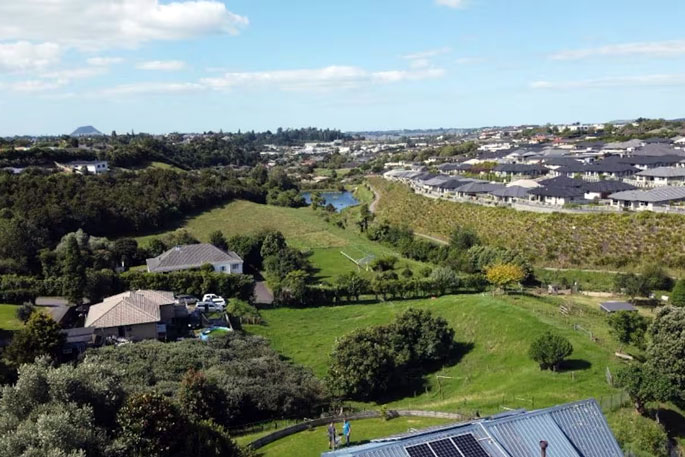A Tauranga former MP and deputy mayor faces opposition from the council and his neighbours over plans to subdivide greenbelt-zoned land for three new houses.
“We have a housing crisis in our city, and if it’s as difficult as this to try to get a few houses enabled it’s no wonder …” Larry Baldock told a hearing to consider his application last week.
Baldock and his wife, Barbara, applied through their Sarana Superannuation Trust for resource consent to create three vacant lots on a 3.85ha site in Pyes Pa.
Neighbours lodged 17 submissions opposing the proposal, raising issues including the greenbelt zone being eroded, traffic impacts and maintenance of a camelia hedge. There were also two submissions in support and one neutral.
A Tauranga City Council planning report recommended the application be refused because its impact would be “at odds” with expectations for the greenbelt zone.
The site has homes, planted areas, grazing paddocks and a stormwater pond. It is at the bottom of a right-of-way (Row) from the Hampstead Court cul-de-sac.
The council appointed Auckland independent commissioner Robert Scott to decide on the application. Scott heard from Larry Baldock, planners, technical experts and opposition submitters on Wednesday.
 Looking north across the site towards the stormwater reserve.
Looking north across the site towards the stormwater reserve.
Baldock is a former United Future MP who served terms on the Tauranga City Council until it was replaced with commissioners in 2020. He ran unsuccessfully in July’s council election and last year’s Tauranga electorate byelection.
He told the hearing the Pyes Pa land was bought 32 years ago and in the past 20 years his family had seen development progress in and around their area.
“We have had consents approved previously and, as a result, we do provide good housing for people who live in our area.”
Baldock said he was on the select committee in Parliament that reintroduced limited notification under the Resource Management Act and 57 property owners had been notified of his application.
He was proud no Copper Crest retirement village residents, who overlooked the greenbelt, had opposed it, and noted his family had put up with the years-long development of the village.
“We all have to make some contributions and accept some things we may not want to if we are going to live in a city that grows and provides for its people.”
 The subdivision site is outlined in blue in the greenbelt zone. Image / Tauranga City Council
The subdivision site is outlined in blue in the greenbelt zone. Image / Tauranga City Council
Council planner Ethan Dods’ report recommending the application be refused found this greenbelt area was “at a tipping point” for development.
He wrote the proposal had “unacceptable” impacts and went against the “low-density, open and natural character” intended for the zone.
Its undersized allotments, reduced setbacks and access provisions did not comply with city rules.
Submitters Reverend Deborah Garrett, Margaret Gibbs and Shane Pepperell spoke opposing the application, and written submissions from two other couples were also read out.
Pepperell said the greenbelt zone had been “drastically reduced” in the past 20 years by “urban sprawl”, and worried this development could pave the way for more of the same.
“Privacy and noise from additional occupants is not what we expect from a rural outlook.”
He wanted assurances a camelia privacy hedge along the right-of-way would be maintained at 2m to 3m tall, which Baldock agreed to.
 A scheme plan showing the eight proposed lots in the subdivision. Image / Momentum Planning and Design
A scheme plan showing the eight proposed lots in the subdivision. Image / Momentum Planning and Design
Gibbs likened the undersized sections to “in-fill housing” common in residential areas but “not a look we want in our greenbelt zones”. She feared setting a precedent for other greenbelts.
Traffic through Hampstead Court was another concern. She said there was already “considerable congestion” at peak times and on “numerous occasions” cul-de-sac residents needed to brake suddenly for vehicles speeding out of the Row.
In her view, the “business proposition” benefitted Baldock but detrimentally impacted the area through extra traffic, noise and rubbish during and after construction.
Garrett said the greenbelt was one of the key attractions when she bought her home of 10 years, and if the subdivision was approved hers would be one of the most impacted.
She echoed concerns about traffic, especially big construction vehicles, and worried making the judder bar bigger – a suggestion to address speeding – might result in vibration damage to her home, as had been seen elsewhere in Tauranga.
She said cul-de-sac residents opposed the application because of the “significant impact” anticipated for their homes and wellbeing.
In his reply, Baldock said he was prepared to negotiate some consent conditions, including no further subdivision of the “balance lot” encompassing most of the green area.
Some submitters’ concerns, such as around flooding, were already mitigated in the plan and others he was working on, such as speeding in the Row but he would not make the judder bar bigger unless it would help and not damage homes.
Baldock argued expert assessments had generally found his plans acceptable, so he struggled to understand how the total impacts reached a “tipping point”.
He said greenbelt areas had already gone for housing.
“These things are happening … We’re short of land in this city.”
His plan would not ruin the views and there would still be cows, trees and birds adding to a more rural atmosphere.
“If [the application] doesn’t get approved, that’s a lot of money down the drain.”
Scott reserved his decision.



0 comments
Leave a Comment
You must be logged in to make a comment.